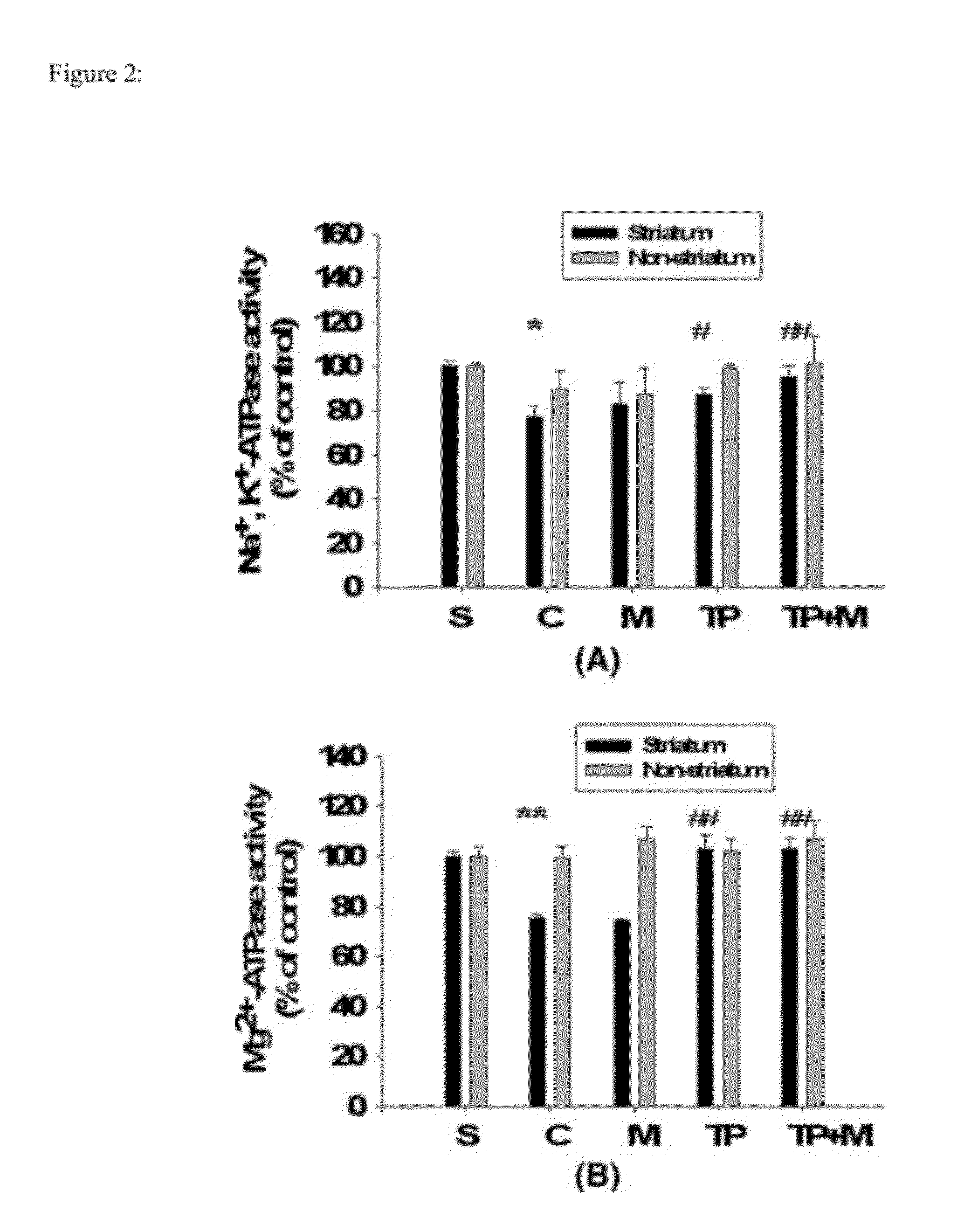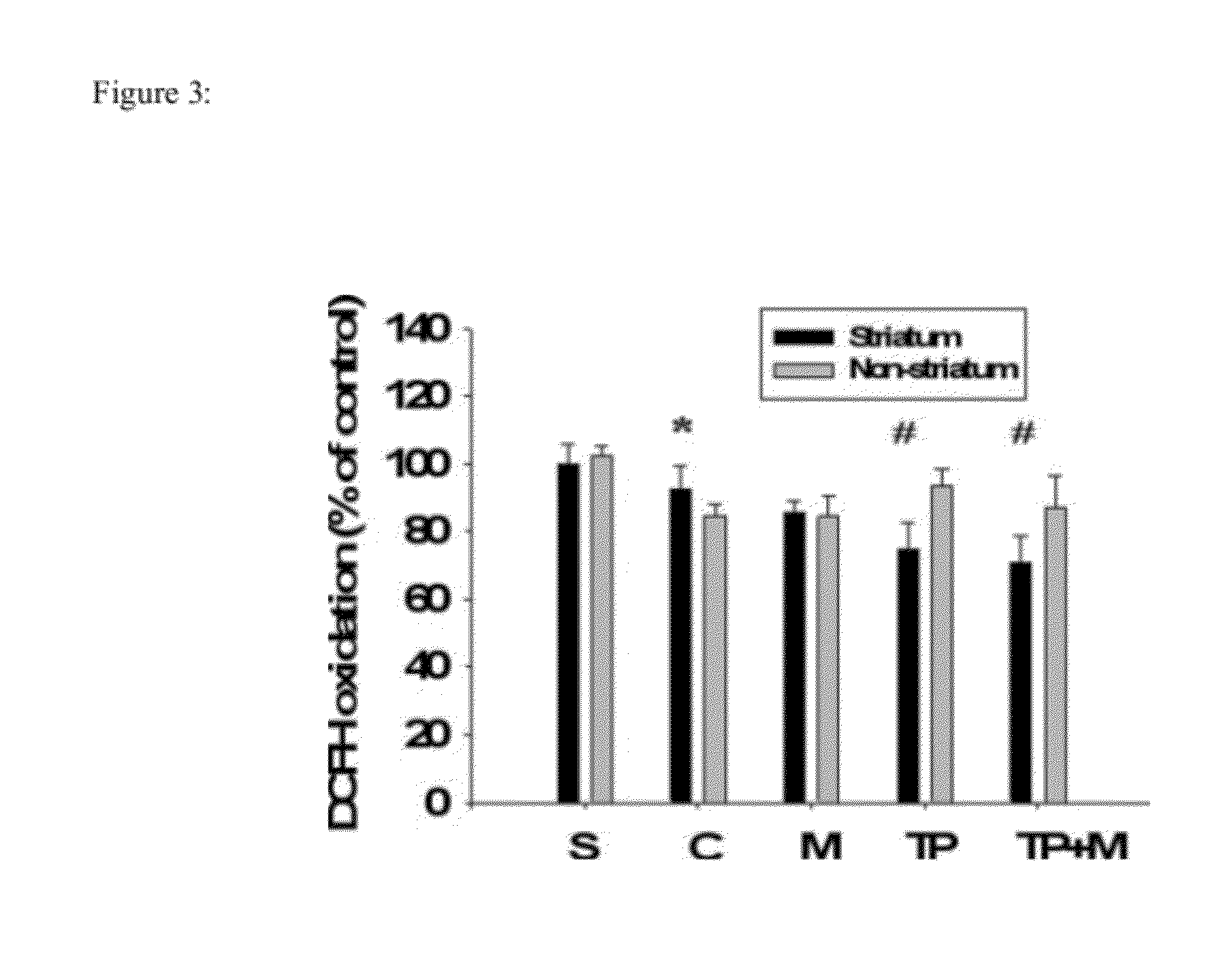Composition and method for neuroprotection against excitotoxic injury
a neuroprotective and excitotoxic technology, applied in the direction of biocide, drug composition, cardiovascular disorder, etc., can solve the problems of increased intracellular calcium and excitotoxicity, unacceptable clinical side effects, and excessive amount of casup>2, and achieve the effect of reducing locomotor activity, increasing locomotor activity, and reducing locomotor activity
- Summary
- Abstract
- Description
- Claims
- Application Information
AI Technical Summary
Benefits of technology
Problems solved by technology
Method used
Image
Examples
example 1
Mice
[0035]The experiment protocols were approved by the Hospital Animal Research Committee of National Taiwan University Hospital. Adult male ICR mice weighing 20-25 g were used in this example.
Treatment of Mice
[0036]Memantine hydrochloride (>98.5% white crystalline powder) was supplied by Lotus Pharmaceutical Co., Ltd. (Taipei, Taiwan). Tea polyphenols were isolated from Longjing green tea with the following composition: epigallocatechin, 14.69%; catechin, 1.13%; epigallocatechin-3-gallate, 41.34%; epicatechin, 5.47%; gallocatechin-3-gallate, 5.16%; epicatechin-3 gallate, 12.54%; coffein, 0.95%; and other catechin derivatives, 18% (Yeh C W, Chen W J, Chiang C T, Lin-Shiau S Y, Lin J K. 2003. Suppression of fatty acid synthase in MCF-7 breast cancer cells by tea and tea polyphenols: a possible mechanism for their hypolipidemic effects. Pharmacogenomics J 3: 267-276.). Memantine (10 mg / kg / day), tea polyphenol (60 mg / kg / day), or a combination (memantine 5 mg / kg / day plus tea polyphenol...
example 2
Animal Preparations
[0057]The male mice (ICR strain) weighting 18-20 g were housed at 22±1° C., under a 12 h light-dark cycle with food and water available ad libitum. Animals were habituated to the housing conditions for one week prior to the experiments. Behavioral testing was carried out during the light portion of the cycle. The experimental protocols were approved by the Hospital Animal Research Committee of National Taiwan University Hospital.
Isolation and Preparation of Tea Polyphenols
[0058]TP (tea polyphenol) was isolated according to the procedure described in example 1.
Statistic
[0059]Statistical comparisons between study groups were performed using one-way ANOVA test followed by post hoc multiple comparison with Dunnett's test. Factors are different groups. In comparing seizure frequency, Chi square tests were performed. P values of less than 0.05 were considered to be statistically significant.
Seizure Score
[0060]In NMDA-treated mice, seizures developed through a sequence o...
PUM
| Property | Measurement | Unit |
|---|---|---|
| Ratio | aaaaa | aaaaa |
| Stress optical coefficient | aaaaa | aaaaa |
| Antioxidant | aaaaa | aaaaa |
Abstract
Description
Claims
Application Information
 Login to View More
Login to View More - R&D
- Intellectual Property
- Life Sciences
- Materials
- Tech Scout
- Unparalleled Data Quality
- Higher Quality Content
- 60% Fewer Hallucinations
Browse by: Latest US Patents, China's latest patents, Technical Efficacy Thesaurus, Application Domain, Technology Topic, Popular Technical Reports.
© 2025 PatSnap. All rights reserved.Legal|Privacy policy|Modern Slavery Act Transparency Statement|Sitemap|About US| Contact US: help@patsnap.com



